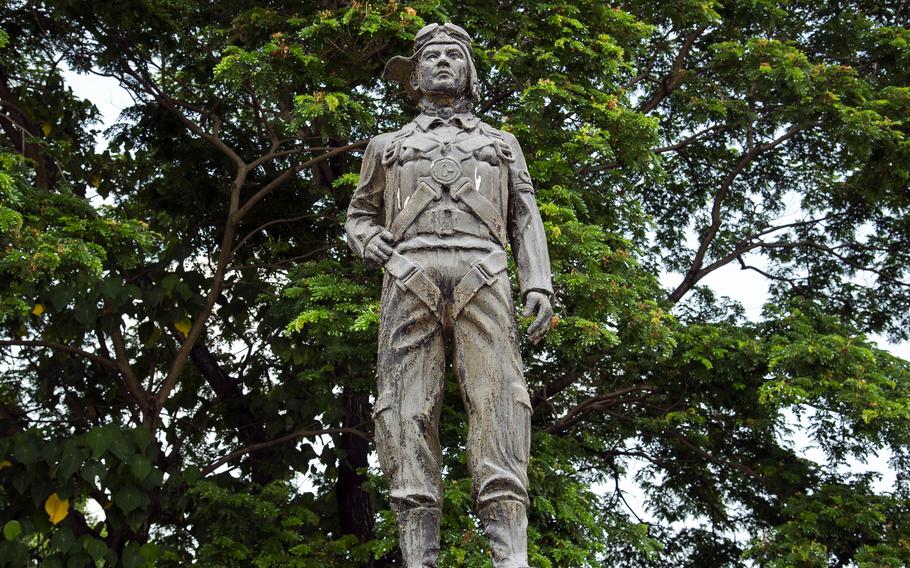
This roadside memorial near Clark Air Base in the Philippines reminds visitors that Japanese pilots on suicide missions took off nearby from “the very first Japanese Kamikaze Airfield.” (Jonathan Snyder/Stars and Stripes)
CLARK AIR BASE, Philippines — Cars, trucks and motorcycles buzz along a road outside this Philippine air force installation, once the domain of the U.S. Air Force and the Imperial Japanese Navy.
U.S. F-16 Fighting Falcons recently roared overhead on their way to Cope Thunder, a series of drills by the U.S. and Philippine militaries.
Nearly 80 years ago, the fighters flying here belonged to imperial Japan, and some were on a one-way attempt to turn back an Allied fleet moving to expel the Japanese from the Philippines.
A roadside memorial near Clark’s Mabalacat gate reminds visitors that pilots on suicide missions took off nearby from “the very first Japanese Kamikaze Airfield,” Mabalacat East.
“The people of Mabalacat were innocent victims caught in a senseless war between foreign powers for world supremacy,” a plaque on the memorial states. “The cause and demise of the Kamikaze pilots is an important part of a liberative struggle of the Mabalaquenas and the entire Filipino nation to unchain the fetters that bind them.”
Japanese forces captured Clark — then a U.S. Army Air Corps base — in January 1942 and turned it into a major hub for Japanese air operations.
The first kamikaze attack from Mabalacat took place at 7:25 a.m. Oct. 25, 1944, when flight leader Lt. Yukio Seki flew his plane into the Casablanca-class escort carrier USS St. Lo near Samar Island. The carrier sank within 20 minutes.
Kamikaze attacks from Mabalacat also damaged the carriers USS Kalinin Bay, USS Kitkun Bay, USS Sangamon, USS Santee, USS Suwannee and USS White Plains, according to the plaque.
Vice Adm. Takijiro Onishi is credited with creating the kamikaze unit at the base with 23 volunteers from the 301st Air Fleet under Capt. Sakae Yamamoto.
The first kamikaze group, led by Seki, was called the Shinpu Special Attack Corps and was divided into four units: Shikishima, Yamato, Asahi and Yamazakura, according to the plaque.
Chief Warrant Officer Hiroyoshi Nishizawa, a Japanese fighter ace, reported the first mission’s success to Lt. Cmdr. Tadashi Nakajima at Cebu. Nakajima’s 201st Air Group carried out the first kamikaze attacks, according to the U.S. Naval Institute.
Despite their repeated and costly attacks, the kamikaze did not turn back the Allied fleets and the Japanese were expelled from the Philippines and eventually defeated at home.
Japanese fighter jets — a pair of Japanese F-15J Eagles — returned to Clark and the Philippines in December for the first time since World War II.
The roadside memorial in Mabalacat city, 56 miles north of Manila, occupies a site along the central frontage of the former Japanese airfield. It consists of a large torii gate, commonly found at the entrances to Shinto shrines, a statue of a Japanese pilot and a wall engraved with Japan’s rising sun flag and the Philippines’ national flag.
It was built “not for the glorification of the kamikaze but rather for the promotion of goodwill, peace and friendship among the nations,” the plaque states.
The memorial, according to the plaque, aims to remind visitors that the kamikaze phenomenon should never happen again.